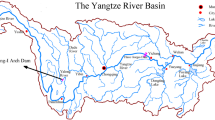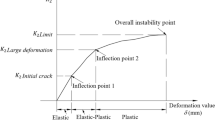Abstract
The Xiaowan super-high arch dam has faced challenging construction problems. Here, we provide a scientifically-based reference for applying geomechanical model testing to support the nonlinear design of super-high arch dams. We applied experimental similarity theory and techniques. Based on four 3D geomechanical model tests, the dam stress characteristics, deformation distribution, and the safety factors of the dam foundation were identified and compared. We also analyzed cracking characteristics of the up- and downstream dam surfaces and induced joints in the dam heel, the rock mass failure process of the dam-foundation interface, and the abutments. We propose foundation reinforcement measures for weak rock masses, alteration zones, and other faults in the abutments based on the 3D and plane tests each at a different elevation. The results show that all dam deformations remained normal with no yielding or tensile cracking under a normal water load. The reinforced rock mass increased the crack initial safety in the dam heel and toe by ~20 %. The minimum crack initial safety factor (K 1) of the dam heel was 1.4. The induced joint in the dam heel contributed to a reduction in tensile stress at the upstream dam heel, improving K 1. Compared with similar projects following reinforcement measures, the abutment stiffness and overall stability of the Xiaowan arch dam satisfy operational requirements. Four years of monitoring operations show that key areas near the dam remained normal and the dam foundation is functioning well. Our results may also be applicable to the design and construction of similar projects worldwide.

















Similar content being viewed by others
References
Ashikhmen VA, Pronina LE (1995) Regrouting joints and its effect on the stress-strain state of the Inguri Arch Dam. Hydrotech Construct 28(10):569–580 (translated from: Gidrotekhnicheskoe Stroitel’stvo (10):1–9)
Barla G, Debernardi D, Sterpi D (2012) Time-dependent modeling of tunnels in squeezing conditions. Int J Geomech 12:697–710
Chen XH et al (1984) Structure model test of brittle materials. China Water Power Press, China, pp 1–10
Chow WY, Yang RQ (1984) Determination of stability of arch dam abutment using finite element method and geomechanical models. In: Proc 4th Australia–New Zealand conference on geomechanics, vol 2, Perth, pp 595–600. Publ Barton, Inst of Engineers
Fei WP, Zhang L, Zhang R (2010) Experimental study on a geomechanical model of a high arch dam. Int J Rock Mech Min Sci 47(2):299–306
Fumagalli E (1979) Geomechanical model of the dam foundation. ISRM geomechanical model of the international symposium, Bergamo
Hagin B (2012) Hydropower in Switzerland. Reference module in earth systems and environmental sciences. Compr Renew Energy 6:343–354
Heuer RE, Hendron AJ (1971) Geomechanical model study of the behavior of underground openings in rock subjected to static loads (Report 2)—tests on unlined openings in intact rock. AD report, USA
Jerome MR (1960) Structural model investigations for Oroville dam. Struct Material Res 100(6)
Jiang XL, Cao JG, Sun SW (2002) Geomechanical model test of integrity stability of the Goupitan hyperbolic arch dam. Yangtze River Sci Res Inst 19(6):21–24
Li GR (1958) The Liuxi River Xiaoche arch dam structure model test and stress analysis. Hydroelectric power, pp 1–8
Li TB (2004) Geomechanical model test on abutment stability of arch dam. Chin J Rock Mech Eng 23(6):1670–1676
Li LC, Liu HH (2013) A numerical study of the mechanical response to excavation and ventilation around tunnels in clay rocks. Int J Rock Mech Min Sci 59:22–32
Li ZK, Liu H, Dai R, Su X (2005) Application of numerical analysis principles and key technology for high fidelity simulation to 3-D physical model tests for underground caverns. Tunn Undergr Space Technol 20:390–399
Li LC, Yang TH, Liang ZZ, Tang CA (2011) Numerical investigation of groundwater outbursts near faults in underground coal mines. Int J Coal Geol 85:276–288
Lin P, Zhou WY, Yang Q, Hu YJ (2004) A new three-dimensional FEM model on arch dam cracking analysis. Key Eng Mater 261–263:1569–1574
Lin P, Wang RK, Kang SZ, Zhang HC, Zhou WY (2011) Key problems of foundation failure, reinforcement and stability for super high arch dams. Chin J Rock Mech Eng 30(10):1945–1958
Lin P, Kang SZ, Li QB, Wang RK, Wang ZL (2012) Evaluation of rock mass quality and stability of Xiluodu arch dam under construction phase. Chin J Rock Mech Eng 31(10):2042–2052
Lin P, Liu XL, Hu Y, Xu WB, Li QB (2013a) Deformation and stability analysis of Xiluodu arch dam under stress-seepage coupling condition. Chin J Rock Mech Eng 32(6):1137–1144
Lin P, Zhou YN, Liu HY, Wang C (2013b) Reinforcement design and stability analysis for large-span tailrace bifurcated tunnels with irregular geometry. Tunn Undergr Space Technol 38(9):189–204. doi:10.1016/j.tust.2013.07.011
Liu J, Feng XT, Ding XL, Zhang J, Yue DM (2003) Stability assessment of the Three-Gorges Dam foundation, China, using physical and numerical modeling—Part I: physical model tests. Int J Rock Mech Min Sci 40:609–631
Liu HY, Small JC, Carter JP, Williams DJ (2009) Effects of tunnelling on existing support systems of perpendicularly crossing tunnels. Comput Geotech 36:880–894
Luo D, Lin P, Li QB, Wang C (2014) Performance analysis of Xiluodu super-arch dam in impounding period. Chin J Hydraul Eng 45(1):18–26
Pan JZ (2004) Ultra-high arch pivot and key issues. China Electric Power Press, pp 1–2 (prefaced by Lizan, Chenfei, Zheng Jianbo et al.)
the PSCG of PRC 2007 Design criteria for concrete arch dam. National Development and Reform Commission of the People’s Republic of China, Beijing, pp 128–129
Wang GL, Zhan CH, Guo ZS, Jin F (1998) Study On upstream bottom joint for improving the stress conditions of high arch dam. J Hydraul Eng 1:69–75
Wang RK, Lin P, Zhou WY (2007) Study on cracking and stability problems of high arch dams on complicated foundations. Chin J Rock Mech Eng 26(10):1951–1958
Wong RHC, Lin P, Tang CA (2006) Experimental and numerical study on splitting failure of brittle solids containing single pore under uniaxial compression. Mech Mater 38:142-159
Wu FQ, Liu T, Liu JY, Tang XL (2009) Excavation unloading destruction phenomena in rock dam foundations. Bull Eng Geol Environ 68:257–262. doi:10.1007/s10064-009-0202-5
Zhang L, Ma YQ, Hu CQ (1994) 3D geomechanical model test of high slope stability. Design Hydroelectr Power Stn 10(3):39–50
Zhou WY, Lin P, Yang RQ, Yang Q (2008a) Geomechanical model test methods and application of high arch dam. China Water Power Press, Beijing, pp 190–204
Zhou WY, Lin P, Zhou YN, Yang Q (2008b) Research on concrete socket and peripheral joint for high arch dam foundation. Chin J Rock Mech Eng 27(10):1959–1967
Zhou WY, Lin P, Yang Q, Yang RQ, Zhou Z (2008c) Experimental research on stability of Jinping high slope with three-dimensional geomechanical model. Chin J Rock Mech Eng 27(5):893–901
Zhu WS, Li Y, Li SC, Wang SG, Zhang QB (2011) Quasi-three-dimensional physical model tests on a cavern complex under high in situ stresses. Int J Rock Mech Min Sci 48(2):199–209
Acknowledgments
This research work was supported by National Natural Science Foundation of China (No. 11272178), the National Basic Research Program of China (973 Program) Grant No. 2011CB013503, and the Tsinghua University Initiative Scientific Research Program. The authors are very grateful to Prof. Yang RQ and Shen DL, and the Kunming Hydroelectric Investigation and Design Institute, China Hydropower Engineering Consulting Group Co. for support this study. The authors are also very grateful to Prof .Giovanni Barla, Anson Elaine and two reviewers for their critical recommendations which helped the author to improve this paper significantly.
Author information
Authors and Affiliations
Corresponding author
Rights and permissions
About this article
Cite this article
Lin, P., Zhou, W. & Liu, H. Experimental Study on Cracking, Reinforcement, and Overall Stability of the Xiaowan Super-High Arch Dam. Rock Mech Rock Eng 48, 819–841 (2015). https://doi.org/10.1007/s00603-014-0593-x
Received:
Accepted:
Published:
Issue Date:
DOI: https://doi.org/10.1007/s00603-014-0593-x




